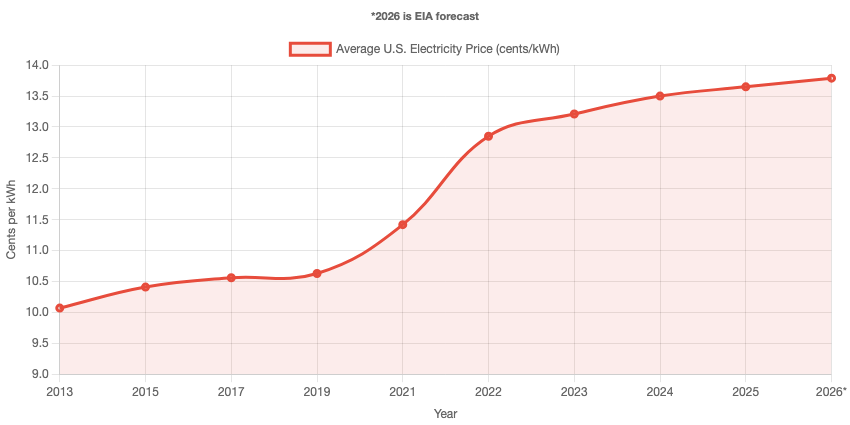Author’s Note: I think I finally figured out why the prices of everything have gone up so dramatically and so quickly. I had an “aha moment.” Some people might be saying it’s more of a “duh” moment, but hear me out.
I’ve been thinking about this for years. We all know about the hyperinflation under Biden, and I’ve taken that into account. I was raised to be very price-sensitive when it comes to groceries, and during my MBA program, I had a professor who focused exclusively on grocery stores. I’ve analyzed the prices of nearly everything in grocery stores when I visit, which I do several times a week. But it’s not just food prices—the cost of everything is through the roof.
Cars, for example. Think about how quickly the price of a new pickup truck escalated. But what I realize is going on is that the problem at hand—not just the myriad symptoms—is energy.
The Energy Price Surge: The Numbers Don’t Lie
27%
Nominal electricity prices have risen 27% since 2019, with a 21% increase since 2021 alone. Even adjusting for inflation, electricity prices have risen 4.5-4.9% in real terms.
Source: Resources for the Future, 2024
Electricity Price Growth Dramatically Outpaced Historical Trends

Data: U.S. Energy Information Administration & U.S. Chamber of Commerce
14.3%
In 2022, electricity prices surged 14.3%—double the overall inflation rate that year. This was the highest year-over-year growth since the beginning of the century.
Source: Utility Dive, 2023
Why This Matters: Energy is Embedded in Everything
If you pay electric bills (and most adults do), you’ve certainly noticed the dramatic increase in electricity costs. And if you run a business dependent on electricity, your costs have suddenly gone up that much as well. The types of businesses that got me thinking about this were coin-operated laundries—self-service laundromats—and how, as far as I know, the cost of using their machines hasn’t increased as dramatically. This is somewhat unusual because their whole business revolves around using water and electricity non-stop.
But if you think on a larger scale, consider grocery stores that have to keep all their products cold and frozen, or car manufacturers who run entire plants 24/7/365 with robots and massive climate-controlled buildings. The amount of energy that a huge manufacturing plant like that uses must be incredible.
The Evidence: Energy’s Share of Business Costs
Grocery Stores
40-50%
Of total electricity use goes to refrigeration alone. An average supermarket spends $200,000 annually on energy.
Source: Energy Star, 2024
Food Manufacturing
15%
Energy accounts for 15% of total operating costs in food and beverage manufacturing.
Source: Centrica Business Solutions
Manufacturing Sector
24-25%
Manufacturing consumed approximately 24 quads of energy in 2018, representing 25% of total U.S. energy consumption.
Source: U.S. Dept. of Energy
Industrial Sector
26%
The industrial sector consumed 26% of total energy in the EU in 2014, with similar patterns in the U.S.
Source: Eurostat
Where Energy Costs Hit Hardest: Grocery Store Energy Breakdown

Data: U.S. Energy Information Administration
The Ripple Effect
I’ve asked lots of experts, friends, and anyone I can about the theory behind this incredible price surge across the board. Although I’ve gotten interesting answers, most of them involve the symptoms, not the actual problem. But I truly believe now that it all has to do with energy policy in this country—something changed at some point where energy costs increased dramatically.
22.55%
The nationwide average electricity price has increased 22.55% over just five years (2019-2024). Some states like California saw a staggering 58.45% increase during this period.
Source: U.S. Chamber of Commerce, 2024
Why Energy Costs Cascade Through the Economy
When a grocery store’s electricity bill increases by 20-30%, those costs must be passed on. The store needs to keep the lights on, the freezers running, and the climate control functioning. When a manufacturing plant’s energy costs spike, the products they make—cars, appliances, packaged goods—all become more expensive.
The beauty of this theory is its simplicity: energy is the one input that touches virtually every aspect of production and distribution. It’s not just about transportation fuel (though that matters too). It’s about:
- The electricity to run assembly lines 24/7
- The massive refrigeration systems in every grocery store and restaurant
- The climate control for warehouses and retail spaces
- The power for data centers that enable modern commerce
- The energy-intensive production of materials like steel, aluminum, and plastics
My Background and Next Steps
I intend to get to the bottom of it and do some research, but I already have my eyes on Biden-era energy policy that I think I may have somehow missed. I follow politics closely and know what bills are being fought over and lobbied for on Capitol Hill. Energy policy is certainly something that would come across my radar, but that doesn’t mean it couldn’t escape me. Plus, I want facts.
So I’m just posting this as a preliminary theory about what’s going on with prices. I’m very familiar with energy policy—I’ve done work with Southern Company as a consultant. One project I worked on for them was to give a presentation on what the future of energy could and should look like in 5, 10, 20, 50, and 100 years. It was a big job.
The overarching theme of what I discovered was that nuclear is what we should be most reliant on, followed by coal (only because of cost), and then have a blend of alternative power sources like hydro, wind, solar, and even oil-based and new, very obscure technologies. I’m happy to know that new nuclear plants are being built and are being opened right now, and Trump is all about drilling and keeping petroleum prices down. But Biden was all about the Green New Deal and sinking everything we had into losing bets (solar, not just alternative energies) while at the same time shutting down our existing utilities.
The Bottom Line
Energy isn’t just another cost of doing business—it’s the foundational cost that determines the price of nearly everything else. When energy prices spike by 20-30% or more, those increases ripple through every sector of the economy. The grocery store’s refrigeration bill, the manufacturer’s production costs, the delivery truck’s fuel—all of it ties back to energy policy and energy prices.
This isn’t about politics or blame—it’s about understanding the mechanism. If we want to control inflation and bring prices down, we need to focus on the root cause: energy costs. Everything else is just treating symptoms.
